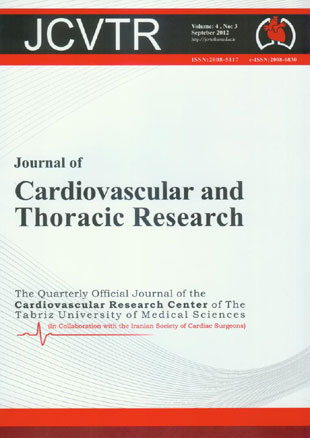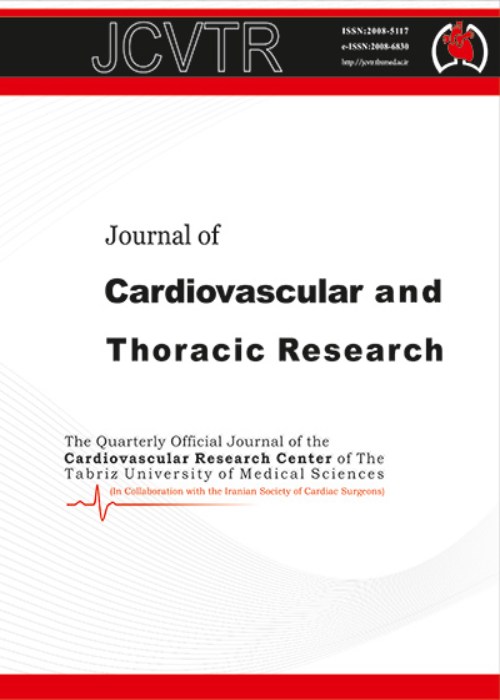فهرست مطالب

Journal of Cardiovascular and Thoracic Research
Volume:4 Issue: 3, Sep 2012
- تاریخ انتشار: 1391/07/18
- تعداد عناوین: 8
-
-
Page 61IntroductionDyslipidemia is an important risk factor in cardiovascular diseases. Different studies have shown that Apolipoprotein B (Apo B) is one of the best predictors in determining cardiovascular diseases and patients follow up after cardiovascular events. We hypothesized that there is a relation between Apo B levels and cardiovascular events in patients who have myocardial infarction (MI). In addition, Apo B may be an appropriate marker for following these patients after MI.MethodsIn this study, 220 patients with acute myocardial infarction were allocated at their admission to the hospital. They were followed for three months after MI and their morbidity and mortality rates were evaluated. Apo B levels were measured immunoturbidimetrically.ResultsApo B levels were significantly higher in patients with the events including coronary artery bypass grafting (CABG), percutaneous coronary intervention (PCI) and malignant arrhythmias (P = 0.001).ConclusionApo B levels can be an appropriate indicator of cardiovascular events in patients after MIKeywords: Cardiovascular Morbidity CABG PCI
-
Page 65Introduction
Postoperative pain as an important medical concern is usually treated by opioids which also are of various inevitable side effects. The aim of this study was to assess the efficacy of multimodal preincisional premedication on preventing postcholecystectomy acute pain.
MethodsIn a randomized clinical trial, sixty patients undergoing open cholecystectomy were randomized into two groups. Before anesthesia induction, Diclofenac suppository (100 mg) and oral Clonidine (0.2 mg) were administered in the first group. Immediately before operation, patients received Ketamine (1 mg/kg IV) while the control group received placebo. The site of incision was infiltrated by the surgeon with 20 mL Bupivacaine 0.25% in both groups. Anesthesia induction and maintenance were similar in both groups. The severity of pain was recorded 2, 4, 6, 12, 24 and 48 hours after operation according to Visual Analogue Scale.
ResultsThe severity of pain at two defined stages (6 and 12 hours later) was significantly less in the intervention group than the control group (P<0.005). The average pain severity score was less than the control group (P<0.005).
ConclusionIn our study, the administration of Clonidine, Diclofenac and Ketamine and bupivacaine infiltration to the site of incision, altogether was associated with a significant decrease in pain score and opioid requirement after cholecystectomy in comparison to bupivacaine infiltration to the site of incision.
Keywords: Postoperative Pain, Multimodal Analgesia, Postoperative Opioid -
Page 69IntroductionTo find a relation between extracellular over fluid and inferior vena cava index as a noninvasive, cost effective and accessible method.MethodsIn a cross sectional study 54 cases (no edema 30, mild and moderate 13 and significant edema 11 cases) entered to study. Inferior vena cava index (IVCi) measured by difference of inspiration to expiration divided to maximum size multiply by 100, we also find delta ratio as difference of maximum to minimum size of inferior vena cava. All data expressed by rate and ratio, relation of edema severity to IVCi or delta ratio performed by mann whitney and regression test, P l ess t han 0. 05 w as s ignificant.ResultsIVCi in 30 cases with no edema, 13 cases with mild to moderate and 11 cases with significant edema were %46±16, %42±16, %38±17, there is a reverse relation of IVCi and edema severity but these relations were not significant (P>0.05).Averaged Delta ratio(millimeter) decreased in severe edema but it was not significant(3.7mm±2 vs. 2.8mm±1.6). In edematous conditions IVCi and delta ratio decrease but these changes are not significant for edema severity estimation.Keywords: Inferior Vena Cava Index Edema Children
-
Page 73IntroductionUnsuccessful tracheal intubation is considered the most common cause of anesthesia death or brain damage. This study delineates our experience recommending modifications in the cricothyroidotomy technique.MethodsThirty emergency medicine residents of participated in a study performed on the human simulator moulage in Skill Laboratory of Tabriz University of Medical Science. The cricothyroid membrane was punctured using a 16-gauge cannula. Later, J guide wire was advanced into trachea and standard 16-gauge intravenous cannula with a removable needle stylet withdrawn after the puncture being dilated by a dilator. Consequently, a cuffed tracheal tube (ID= 6) was introduced from the foramen.ResultsFrom 30 residents, 18 residents performed cricothyroidotomy within 1 minute, 7 residents in 2 minutes and 5 residents failed to fulfill the procedure.ConclusionSeveral studies using cadavers and human simulators have demonstrated the pre-hospital feasibility of this technique. However, descriptions of clinical pre-hospital experience with percutaneous cricothyroidotomy are limited. This study shows that skill lab may help residents to acquire techniques required in management of difficult airway.Keywords: Percutaneous Cricothyroidotomy Difficult Airway Management Skill Laboratory
-
Page 77IntroductionDepression is one of the Common psychological disorders. From the cognitive point of view, the unhealthy attitudes increase the severity of the depression. The aim of this study was to investigate depression and unhealthy attitudes in coronary patients hospitalized at Tabriz Shahid Madani Heart Center.MethodsOne hundred twenty eight hospitalized patients having myocardial Infarctions were studied regarding unhealthy attitudes, severity of depression and demographic data.ResultsThe study showed a significant relation between unhealthy attitudes, BDI (Beck Depression Inventory) and severe depression. Moreover, a significant relation existed between gender and depression (P=0.0001). In addition, the level of education increased the intensity of unhealthy attitudes (P=0.0001). Several researches in both outside and inside Iran support the idea.ConclusionBased on present study and more other investigations, it can be suggested to provide the necessary elements and parameters such as antidepressant medication, psychologists, complementary treatment for coping with negative mood and its unwanted consequences.Keywords: Depression Coronary Artery Disease BDI Test
-
Page 81IntroductionThere are limited data comparing long-term efficacy and safety of OPTIMA tacrolimus-eluting stent (TES) with Dual Antiplatelet Therapy (DAT) in daily practice. Therefore, we evaluated the safety and performance of OPTIMA TES with 2 or 6-month dual antiplatelet therapy in a 12-month follow up period.MethodsIn a prospective, non-randomized single center registry in which 106 patients that underwent percutaneous coronary intervention with the OPTIMA TES between January 2010 and February 2011 were enrolled. After stenting, 62 patients received DAT for 2 months and the remainder for 6 months. Major Adverse Cardiac Events (MACE), stent thrombosis rate and target lesion revascularization (TLR) were evaluated in a 12-month follow-up period for 2-and 6-month DAT groups.ResultsNo cases with death, MI or stent thrombosis were observed within the 12-month follow-up period in either of the groups. TLR and MACE rates were higher in 6-month DAT group compared to 2-month group (6.8% vs. 3.2% respectively, P=0.001) which may be due to this group having more diffuse disease (23.60±5.69 vs. 20.88±5.14, P=0.018).ConclusionsOPTIMA tacrolimus-eluting stent is safe and efficient with short term DAT period. A randomized trial is needed for better evaluations of OPTIMA TES in daily clinical practice.Keywords: Tacrolimus, eluting Stent PCI Stent Thrombosis Dual Antiplatelet Therapy
-
Assessment of Emergency Medicine Resident's Cardiopulmonary Resuscitation Team in Imam Reza HospitalPage 85Cardiopulmonary resuscitation (CPR) is practiced widely since the first practical report on the efficacy of closed chest massage in 1960.1 Delay in CPR after cardiac arrest could be associated with poor outcome.2 A hospital CPR discharge rate of 1314% was reported from the studies in the 1990s3,4 which has been confirmed by the recent Canadian study.5 Therefore, we decide to study our CPR team which includes emergency residents, nurses, anesthesia technicians and the staff that are involved in resuscitating patients in all hospital wards. Reports of survival after discharge following in-hospital CPR are variable between 7% and 26%.6-8 In our research, most of arrests happened in the morning and asystole rhythm was the most common rhythm; a 40 percent survival rate showed that we can improve our CPR team performance. Recent data have recommended that the successful resuscitation efforts could be prevented by insufficient performance of CPR.8 To increase safety and reduce errors, effective team performance in dynamic and complex environments such as critical care units are required in where decisions are made. 9 There is supporting evidence that suboptimal team performance can have damaging effects. In the context of ACLS training, poor ACLS performance is associated with inefficient leadership and impaired task distribution between the resuscitation team members.10 We studied 422 patients in our research from which 59.5% and 40.5% were male and female respectively. The median age of the patients was 68 (SD: 17.284) years old (mode: 73, oldest: 95, youngest: 1). The mean time of CPR performance was 30 minutes with the minimum of 3 minutes and maximum of 60 minutes. We found that most of our patients who arrested (36%) were admitted in pulmonary ward and after that (18.5%) were admitted in gastroenterology ward. Most of patients (51.7%) had arrested in the morning. 44.3% of patients did not have any definitive diagnosis; however, 5.5% of them had ESRD, 5.2% pneumonia, and 4.3% GI Bleeding. Among patients asystole was the most common pattern (94.3; Figure 1), the other observed patterns are presented in Figure 1. Our CPR team had to intubate 24.4% of the patients while 75.6% were intubated prior to CPR team arrival. Just 40% of the patients could be saved following successful resuscitation. Therefore, based on the obtained data from the present study, it seems that our CPR team work is effective; however, for being more effective and achieving better results, better organization is essential. By having more experienced and efficient team, and also by paying attention to those wards and times that have the most arrests we can be more prepared and therefore perform resuscitation more successfully than before.
-
Page 87Apical Hypertrophic Cardiomyopathy is an uncommon condition constituting 1% -2% of the cases with Hypertrophic Cardiomyopathy (HCM) diagnosis. We interestingly report two patients with apical hypertrophic cardiomyopathy in association with significant pulmonary artery hypertension without any other underlying reason for pulmonary hypertension. The patients were assessed by echocardiography, cardiac catheterization and pulmonary function parameters study.Keywords: Apical Hypertrophic Cardiomyopathy Pulmonary Artery Hypertension Echocardiography


